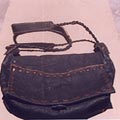Wood-carving has, traditionally, been the forte of the Nepali artisan – using the most primitive of tools they have, over the centuries, endowed the simplest of products with great aesthetic appeal without detracting from their utilitarian value.
DAILY-USE PRODUCTS
Most daily use wooden products are crafted by scooping out the wood with traditional tools. Hollowed out objects like the canoe, mortar, theki (wooden containers for yogurt and sour milk), singmang (container for clarified butter), chauntho (oil container), gauwa (milk container), and ari bowls are been crafted from the wood of the pine and cedar. Lathe machines have been introduced recently for the making of hollowed and cylindrical objects. These are then smoothened with sand-paper and given several coats of varnish to make the surface smooth and shiny. However, some of the hollow wooden objects like the theki, singmang, and chauntho, as well as wooden mortars and bowls, are being replaced with plastic and aluminium products.
- Theki: In carving a theki, a log of wood, preferably cedar, is rotated horizontally and a curved tool is used to slice the wood. As the log of wood rotates, it is scooped little by little. After the required depth is cut, it is refined further and the exterior portion is also cut, giving it the required shape. Thekis come in different sizes with little variation in their shape. They are used for preparing and churning the yogurt.
- Singmang: It is believed that clarified butter or ghee can be kept in a singmang for several years without any preservative.
- Ari: Bowls or ari made of wood are used in making pickles. Any edible item can be kept in such bowls.
FURNITURE, CHESTS, & BOXES
Soft-wood – like chanp (champac), pine, and cedar – is used in Nepal to make furniture, chests, and boxes. Sisso variety of wood is preferred for carving because of its beautiful grain. Chests made of soft-wood were a traditional wedding gift from the parents to the bride. These traditional chests are slowly being replaced by modern metal almirahs or cupboards/wardrobes.
Carved wooden furniture and chests are given a coating of turpentine oil or a mixture of light coloured rosin obtained from the pine trees to highlight the designs.
PROBLEMS & INTERVENTIONS
Traditional craftsmen are now affected by the scarcity of wood due to deforestation. The hard sal wood of the southern plains is rapidly being depleted. Although afforestation programmes have been launched, the requirement of wood far outstrips the supply.
LOCATIONS
Most of the wood-carving is done in Lalitpur and in the Kathmandu Valley.
YOUR VIEWS
PRACTITIONERS: INDIA
Access 70,000+ practitioners in 2500+ crafts across India.
BIBLIOGRAPHY
10,000+ listings on arts, crafts, design, heritage, culture etc.
GLOSSARY
Rich and often unfamiliar vocabulary of crafts and textiles.
SHOP at India InCH
Needs to be written.






